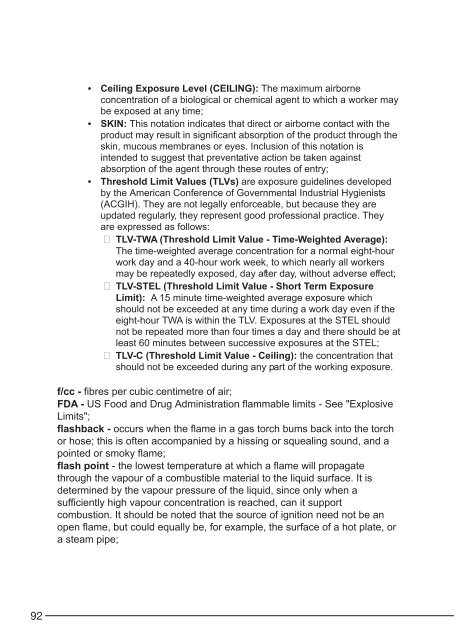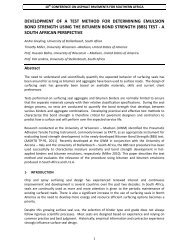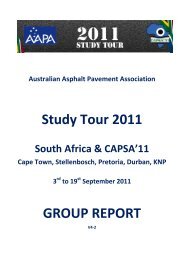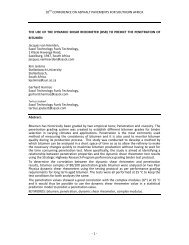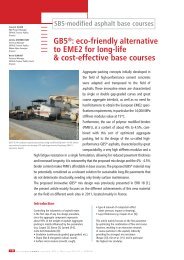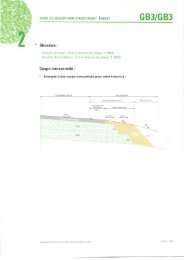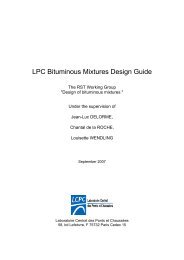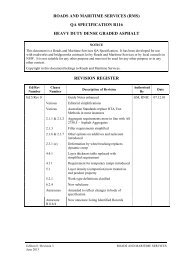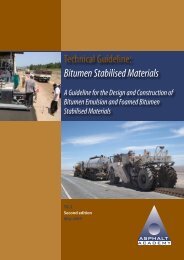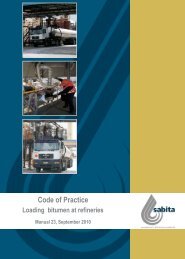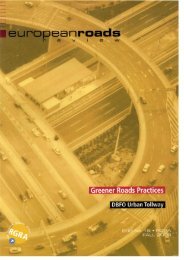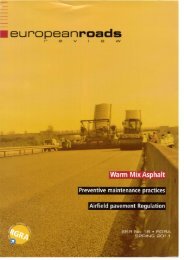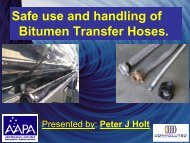Guide to the safe handling of solvents in a bituminous ... - Aapaq.org
Guide to the safe handling of solvents in a bituminous ... - Aapaq.org
Guide to the safe handling of solvents in a bituminous ... - Aapaq.org
- No tags were found...
You also want an ePaper? Increase the reach of your titles
YUMPU automatically turns print PDFs into web optimized ePapers that Google loves.
• Ceil<strong>in</strong>g Exposure Level (CEILING): The maximum airborneconcentration <strong>of</strong> a biological or chemical agent <strong>to</strong> which a worker maybe exposed at any time;• SKIN: This notation <strong>in</strong>dicates that direct or airborne contact with <strong>the</strong>product may result <strong>in</strong> significant absorption <strong>of</strong> <strong>the</strong> product through <strong>the</strong>sk<strong>in</strong>, mucous membranes or eyes. Inclusion <strong>of</strong> this notation is<strong>in</strong>tended <strong>to</strong> suggest that preventative action be taken aga<strong>in</strong>stabsorption <strong>of</strong> <strong>the</strong> agent through <strong>the</strong>se routes <strong>of</strong> entry;• Threshold Limit Values (TLVs) are exposure guidel<strong>in</strong>es developedby <strong>the</strong> American Conference <strong>of</strong> Governmental Industrial Hygienists(ACGIH). They are not legally enforceable, but because <strong>the</strong>y areupdated regularly, <strong>the</strong>y represent good pr<strong>of</strong>essional practice. Theyare expressed as follows: TLV-TWA (Threshold Limit Value - Time-Weighted Average):The time-weighted average concentration for a normal eight-hourwork day and a 40-hour work week, <strong>to</strong> which nearly all workersmay be repeatedly exposed, day after day, without adverse effect; TLV-STEL (Threshold Limit Value - Short Term ExposureLimit): A 15 m<strong>in</strong>ute time-weighted average exposure whichshould not be exceeded at any time dur<strong>in</strong>g a work day even if <strong>the</strong>eight-hour TWA is with<strong>in</strong> <strong>the</strong> TLV. Exposures at <strong>the</strong> STEL shouldnot be repeated more than four times a day and <strong>the</strong>re should be atleast 60 m<strong>in</strong>utes between successive exposures at <strong>the</strong> STEL; TLV-C (Threshold Limit Value - Ceil<strong>in</strong>g): <strong>the</strong> concentration thatshould not be exceeded dur<strong>in</strong>g any part <strong>of</strong> <strong>the</strong> work<strong>in</strong>g exposure.f/cc - fibres per cubic centimetre <strong>of</strong> air;FDA - US Food and Drug Adm<strong>in</strong>istration flammable limits - See "ExplosiveLimits";flashback - occurs when <strong>the</strong> flame <strong>in</strong> a gas <strong>to</strong>rch bums back <strong>in</strong><strong>to</strong> <strong>the</strong> <strong>to</strong>rchor hose; this is <strong>of</strong>ten accompanied by a hiss<strong>in</strong>g or squeal<strong>in</strong>g sound, and apo<strong>in</strong>ted or smoky flame;flash po<strong>in</strong>t - <strong>the</strong> lowest temperature at which a flame will propagatethrough <strong>the</strong> vapour <strong>of</strong> a combustible material <strong>to</strong> <strong>the</strong> liquid surface. It isdeterm<strong>in</strong>ed by <strong>the</strong> vapour pressure <strong>of</strong> <strong>the</strong> liquid, s<strong>in</strong>ce only when asufficiently high vapour concentration is reached, can it supportcombustion. It should be noted that <strong>the</strong> source <strong>of</strong> ignition need not be anopen flame, but could equally be, for example, <strong>the</strong> surface <strong>of</strong> a hot plate, ora steam pipe;92


